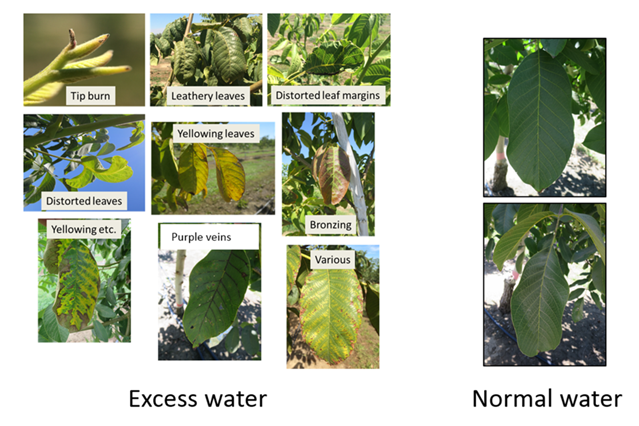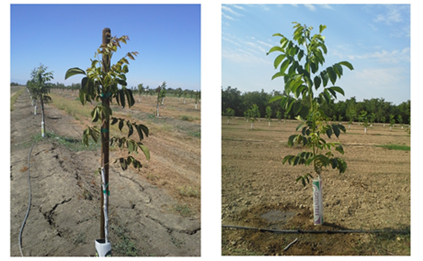Allan Fulton, UCCE Water Resources Advisor, Tehama, Shasta, Glenn and Colusa Counties; and Luke Milliron, UCCE Orchards Advisor, Butte, Tehama and Glenn Counties.
Advanced guidelines for walnut are provided in Table 1 (below). These guidelines consider the actual orchard measurements and normalized measurements after referencing baseline SWP (i.e. bars +/- Table 2 baseline, end of article). Research has shown the optimum crop water stress just before irrigation in walnuts is about -2 to -3 bars below baseline. This tends to correspond with field measurements ranging from -4 to -8. There are exceptions, especially for extraordinarily dry hot weather (e.g. >105 °F and <15 % relative humidity). Under very hot and dry conditions, orchard levels averaging -6 to -10 bars may be reasonable and correspond with -2 to -3 bars below baseline.
| SWP range (bars) | General Stress Level | Baseline consideration for | Water stress symptoms in Walnut | |
| SWP range (bars) | General Stress Level | Normal or Cool Weather | Above Normal and Hot Weather | |
| Higher than -2 | None | Likely above baseline | Very likely above baseline | Not commonly observed, but if measured, they indicate overly wet soil conditions and risk to long term tree root health. Yellowing tree canopies, small leaves, and nuts may be visible. |
| -2 to -4 | None | At or slightly below baseline | Likely to be above baseline | Fully irrigated. Commonly observed when orchards are irrigated according to estimates of real-time evapotranspiration (ETc). If sustained, long term root and tree health may be a concern, especially on California Black rootstock |
| -4 to -6 | Minimal | As mush as 2 bars below typical baseline | At or slightly above baseline | High rate of shoot growth visible, suggested level from leaf-out until mid-June when nut sizing is completed. |
| -6 to -8 | Mild | May be 2 to 4 bars below baseline | Near or possibly above baseline | Shoot growth in non-bearing trees and bearing trees has been observed to decline. These levels do not appear to affect kernel development or quality. |
| -8 to -10 | Moderate | May be 4 to 6 bars below baseline | May be within 2 bars of baseline | Shoot growth in non-bearing trees may stop, nut sizing may be reduced in bearing trees and bud development for next season may be negatively affected. |
| -10 to -12 | High | May be 6 to 8 bars below baseline | Likely 2 to 4 bars below baseline | Temporary wilting of leaves and shrivel of hulls has been observed. New shot growth may be sparse or absennt and some defoliation may be evident. If sustained, nut size will likely be reduced with darker kernel color. |
| -12 to -14 | Very High | May be 8 to 10 bars below baseline | Likely 6 to 8 bars below baseline | Results in moderate defoliation. Should be avoided. |
| -14 to -18 | Severe | Likely 10 to 14 bars below baseline | May be 8 to 10 bars below baseline | Severe defoliation, trees are likely dying. |
| Below -18 | Extreme | Substantially below baseline under all weather conditions | Not commonly measured in walnut. Trees are probably dead or dying. |
University experiments and production experience with intensive irrigation management that sustains orchards near baseline (no to minimal tree stress) throughout the season suggests this management strategy can increase tree loss and shorten the economic life of an orchard. Among the major tree crops grown in the Sacramento Valley, walnut may be especially sensitive to the negative consequences of maintaining a baseline or minimal water stress status. Concerns include higher incidence of root and foliar diseases, lower limb shading and dieback, and shortened orchard life. Orchards where SWP fluctuates more within these optimum ranges may both yield competitively and incur less tree loss.


| Air | 10 | 15 | 20 | 25 | 30 | 35 | 40 | 45 | 50 | 55 | 60 | 65 | 70 | 75 | 80 | 85 | |
| Temp (F) | Air Relative Humidity | ||||||||||||||||
| 60 | -3.8 | -3.7 | -3.7 | -3.6 | -3.6 | -3.5 | -3.5 | -3.4 | -3.3 | -3.3 | -3.2 | -3.2 | -3.1 | -3.1 | -3.0 | -2.9 | |
| 62 | -3.9 | -3.8 | -3.8 | -3.7 | -3.6 | -3.6 | -3.5 | -3.4 | -3.4 | -3.3 | -3.3 | -3.2 | -3.1 | -3.1 | -3.0 | -3.0 | |
| 64 | -4.0 | -3.9 | -3.8 | -3.8 | -3.7 | -3.6 | -3.6 | -3.5 | -3.4 | -3.4 | -3.3 | -3.2 | -3.2 | -3.1 | -3.0 | -3.0 | |
| 66 | -4.0 | -4.0 | -3.9 | -3.8 | -3.8 | -3.7 | -3.6 | -3.5 | -3.5 | -3.4 | -3.3 | -3.3 | -3.2 | -3.1 | -3.1 | -3.0 | |
| 68 | -4.1 | -4.1 | -4.0 | -3.9 | -3.8 | -3.8 | -3.7 | -3.6 | -3.5 | -3.5 | -3.4 | -3.3 | -3.2 | -3.2 | -3.1 | -3.0 | |
| 70 | -4.2 | -4.1 | -4.1 | -4.0 | -3.9 | -3.8 | -3.7 | -3.7 | -3.6 | -3.5 | -3.4 | -3.3 | -3.3 | -3.2 | -3.1 | -3.0 | |
| 72 | -4.3 | -4.2 | -4.2 | -4.1 | -4.0 | -3.9 | -3.8 | -3.7 | -3.6 | -3.6 | -3.5 | -3.4 | -3.3 | -3.2 | -3.1 | -3.0 | |
| 74 | -4.4 | -4.3 | -4.2 | -4.2 | -4.1 | -4.0 | -3.9 | -3.8 | -3.7 | -3.6 | -3.5 | -3.4 | -3.3 | -3.2 | -3.1 | -3.1 | |
| 76 | -4.5 | -4.4 | -4.3 | -4.3 | -4.2 | -4.1 | -4.0 | -3.9 | -3.8 | -3.7 | -3.6 | -3.5 | -3.4 | -3.3 | -3.2 | -3.1 | |
| 78 | -4.7 | -4.6 | -4.5 | -4.4 | -4.2 | -4.1 | -4.0 | -3.9 | -3.8 | -3.7 | -3.6 | -3.5 | -3.4 | -3.3 | -3.2 | -3.1 | |
| 80 | -4.8 | -4.7 | -4.6 | -4.5 | -4.3 | -4.2 | -4.1 | -4.0 | -3.9 | -3.8 | -3.7 | -3.6 | -3.5 | -3.3 | -3.2 | -3.1 | |
| 82 | -4.9 | -4.8 | -4.7 | -4.6 | -4.5 | -4.3 | -4.2 | -4.1 | -4.0 | -3.9 | -3.7 | -3.6 | -3.5 | -3.4 | -3.3 | -3.1 | |
| 84 | -5.1 | -4.9 | -4.8 | -4.7 | -4.6 | -4.4 | -4.3 | -4.2 | -4.1 | -3.9 | -3.8 | -3.7 | -3.5 | -3.4 | -3.3 | -3.2 | |
| 86 | -5.2 | -5.1 | -5.0 | -4.8 | -4.7 | -4.5 | -4.4 | -4.3 | -4.1 | -4.0 | -3.9 | -3.7 | -3.6 | -3.5 | -3.3 | -3.2 | |
| 88 | -5.4 | -5.2 | -5.1 | -4.9 | -4.8 | -4.7 | -4.5 | -4.4 | -4.2 | -4.1 | -3.9 | -3.8 | -3.6 | -3.5 | -3.4 | -3.2 | |
| 90 | -5.6 | -5.4 | -5.2 | -5.1 | -4.9 | -4.8 | -4.6 | -4.5 | -4.3 | -4.2 | -4.0 | -3.9 | -3.7 | -3.6 | -3.4 | -3.2 | |
| 92 | -5.7 | -5.6 | -5.4 | -5.2 | -5.1 | -4.9 | -4.7 | -4.6 | -4.4 | -4.3 | -4.1 | -3.9 | -3.8 | -3.6 | -3.4 | -3.3 | |
| 94 | -5.9 | -5.7 | -5.6 | -5.4 | -5.2 | -5.0 | -4.9 | -4.7 | -4.5 | -4.4 | -4.2 | -4.0 | -3.8 | -3.7 | -3.5 | -3.3 | |
| 96 | -6.1 | -5.9 | -5.7 | -5.6 | -5.4 | -5.2 | -5.0 | -4.8 | -4.6 | -4.4 | -4.3 | -4.1 | -3.9 | -3.7 | -3.5 | -3.3 | |
| 98 | -6.3 | -6.1 | -5.9 | -5.7 | -5.5 | -5.3 | -5.1 | -4.9 | -4.8 | -4.6 | -4.4 | -4.2 | -4.0 | -3.8 | -3.6 | -3.4 | |
| 100 | -6.5 | -6.3 | -6.1 | -5.9 | -5.7 | -5.5 | -5.3 | -5.1 | -4.9 | -4.7 | -4.5 | -4.2 | -4.0 | -3.8 | -3.6 | -3.4 | |
| 102 | -6.8 | -6.6 | -6.3 | -6.1 | -5.9 | -5.7 | -5.4 | -5.2 | -5.0 | -4.8 | -4.6 | -4.3 | -4.1 | -3.9 | -3.7 | -3.4 | |
| 104 | -7.0 | -6.8 | -6.6 | -6.3 | -6.1 | -5.8 | -5.6 | -5.4 | -5.1 | -4.9 | -4.7 | -4.4 | -4.2 | -4.0 | -3.7 | -3.5 | |
| 106 | -7.3 | -7.0 | -6.8 | -6.5 | -6.3 | -6.0 | -5.8 | -5.5 | -5.3 | -5.0 | -4.8 | -4.5 | -4.3 | -4.0 | -3.8 | -3.5 | |
| 108 | -7.6 | -7.3 | -7.0 | -6.8 | -6.5 | -6.2 | -6.0 | -5.7 | -5.4 | -5.2 | -4.9 | -4.6 | -4.4 | -4.1 | -3.8 | -3.6 | |
| 110 | -7.8 | -7.6 | -7.3 | -7.0 | -6.7 | -6.4 | -6.2 | -5.9 | -5.6 | -5.3 | -5.0 | -4.7 | -4.5 | -4.2 | -3.9 | -3.6 | |
| 112 | -8.1 | -7.8 | -7.5 | -7.2 | -7.0 | -6.7 | -6.4 | -6.1 | -5.8 | -5.5 | -5.2 | -4.9 | -4.6 | -4.3 | -4.0 | -3.7 | |
| 114 | -8.5 | -8.1 | -7.8 | -7.5 | -7.2 | -6.9 | -6.6 | -6.3 | -5.9 | -5.6 | -5.3 | -5.0 | -4.7 | -4.4 | -4.0 | -3.7 | |
| 116 | -8.8 | -8.5 | -8.1 | -7.8 | -7.5 | -7.1 | -6.8 | -6.5 | -6.1 | -5.8 | -5.5 | -5.1 | -4.8 | -4.4 | -4.1 | -3.8 | |
| 118 | -9.1 | -8.8 | -8.4 | -8.1 | -7.7 | -7.4 | -7.0 | -6.7 | -6.3 | -6.0 | -5.6 | -5.3 | -4.9 | -4.5 | -4.2 | -3.8 | |
| 120 | -9.5 | -9.1 | -8.8 | -8.4 | -8.0 | -7.6 | -7.3 | -6.9 | -6.5 | -6.1 | -5.8 | -5.4 | -5.0 | -4.6 | -4.3 | -3.9 | |


Leave a Reply